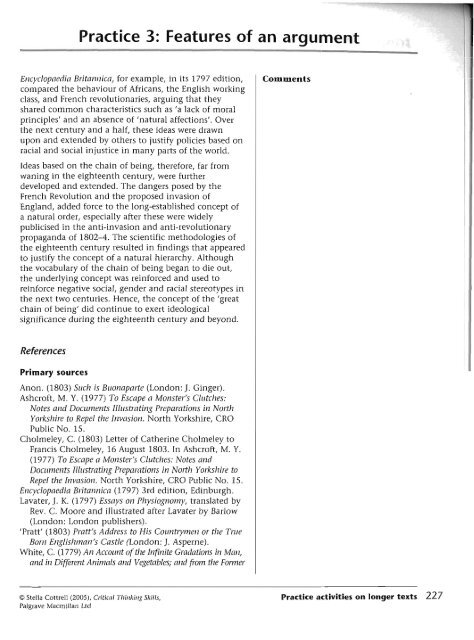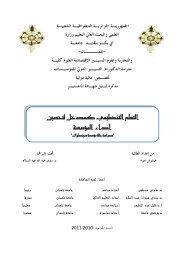Critical Thinking Skills - Developing Effective Analysis and Argument(2)
Critical Thinking Skills - Developing Effective Analysis and Argument(2)
Critical Thinking Skills - Developing Effective Analysis and Argument(2)
You also want an ePaper? Increase the reach of your titles
YUMPU automatically turns print PDFs into web optimized ePapers that Google loves.
Practice 3: Features of an argument<br />
I<br />
Encyclopaedia Britanrzica, for example, in its 1797 edition,<br />
compared the behaviour of Africans, the English working<br />
class, <strong>and</strong> French revolutionaries, arguing that they<br />
shared common characteristics such as 'a lack of moral<br />
principles' <strong>and</strong> an absence of 'natural affections'. Over<br />
the next century <strong>and</strong> a half, these ideas were drawn<br />
upon <strong>and</strong> extended by others to justify policies based on<br />
racial <strong>and</strong> social injustice in many parts of the world.<br />
Ideas based on the chain of being, therefore, far from<br />
waning in the eighteenth century, were further<br />
developed <strong>and</strong> extended. The dangers posed by the<br />
French Revolution <strong>and</strong> the proposed invasion of<br />
Engl<strong>and</strong>, added force to the long-established concept of<br />
a natural order, especially after these were widely<br />
publicised in the anti-invasion <strong>and</strong> anti-revolutionary<br />
propag<strong>and</strong>a of 1802-4. The scientific methodologies of<br />
the eighteenth century resulted in findings that appeared<br />
to justify the concept of a natural hierarchy. Although<br />
the vocabulary of the chain of being began to die out,<br />
the underlying concept was reinforced <strong>and</strong> used to<br />
reinforce negative social, gender <strong>and</strong> racial stereotypes in<br />
the next two centuries. Hence, the concept of the 'great<br />
chain of being' did continue to exert ideological<br />
significance during the eighteenth century <strong>and</strong> beyond.<br />
Comments<br />
References<br />
Primary sources<br />
Anon. (1803) Such is Bz~onaparte (London: J. Ginger).<br />
Ashcroft, M. Y. (1977) To Escape a Monster's Clutches:<br />
Notes <strong>and</strong> Documents Illustrnting Preparations in North<br />
Yorkshire to Repel the Invasion. North Yorkshire, CRO<br />
Public No. 15.<br />
Cholmeley, C. (1803) Letter of Catherine Cholmeley to<br />
Francis Cholmeley, 16 August 1803. In Ashcroft, M. Y.<br />
(1977) To Escape a Monster's Clutches: Notes <strong>and</strong><br />
Doczlments Illtlstrating Preparations in North Yorkshire to<br />
Repel the Invasion. North Yorlcshire, CRO Public No. 15.<br />
Encyclopaedia Britarznica (1797) 3rd edition, Edinburgh.<br />
Lavater, J. K. (1797) Essays on Physiognomy, translated by<br />
Rev. C. Moore <strong>and</strong> illustrated after Lavater by Barlow<br />
(London: London publishers).<br />
'Pratt' (1803) Pratt's Address to His Colintrymoz or the True<br />
Born Englisl~man's Castle (London: J. Asperne).<br />
White, C. (1779) Arz Account of the Infinite Gradations in Man,<br />
<strong>and</strong> in Diffmnt Animals <strong>and</strong> Vegetables; <strong>and</strong> fi-om the Former<br />
O Stella Cottrell (2005), <strong>Critical</strong> Tlzinki~lg<br />
Palgrave Macm~llan Ltd<br />
<strong>Skills</strong>,



